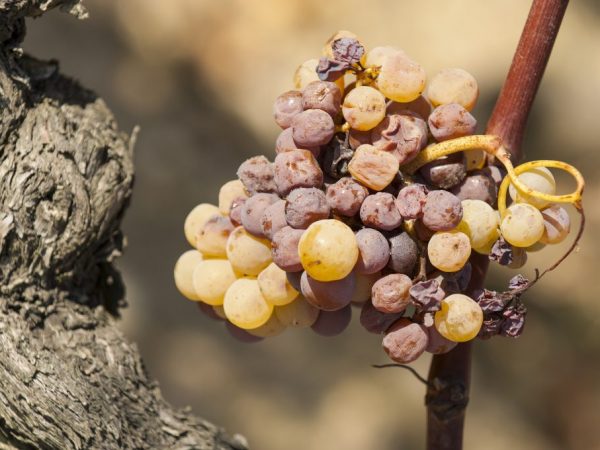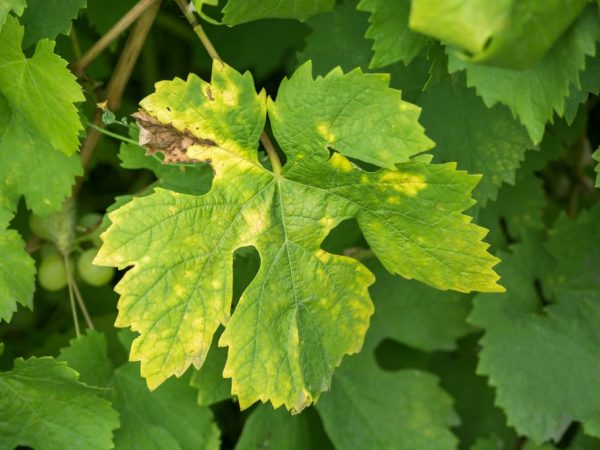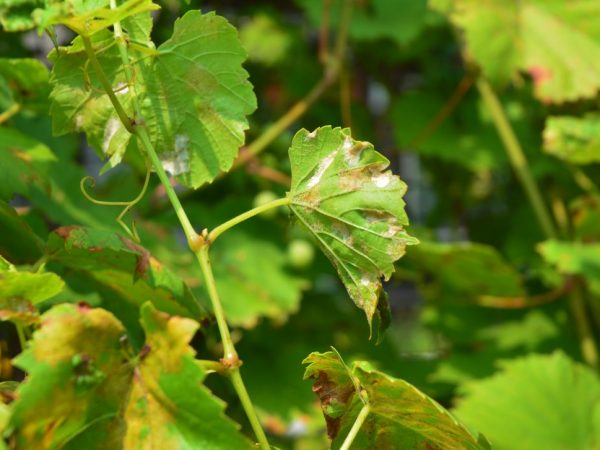How to treat fungus on grapes
When cultivating a horticultural culture, winegrowers often encounter fungal diseases. The fungus on the grapes leads to a decrease in yield and can cause the death of the bush. To preserve the future harvest, measures should be taken in a timely manner and the plantings should be treated with specially designed preparations.

Types of fungus on grapes and their treatment
Principles of treating fungal infections
Against fungal diseases of grapes, chemical preparations are used - fungicides. Adult plants and young seedlings are subject to processing.
The greatest susceptibility to fungal infection is noted in varieties with high taste characteristics. Less sweet varietal species are less susceptible to fungus.
Type of exposure to chemicals:
- local, in which the active substance does not penetrate into the plant cells, but fights the fungal infection externally,
- systemic, in which the active substance affects the infectious agent both inside the plant and outside, their effectiveness is higher, they are not washed off with water, the frequency of treatments is less.
In the fight against fungal diseases on grapes, it is permissible to use folk remedies, but their effectiveness is noticeably lower, and the frequency of use in case of illness is higher.
Fighting mildew
Mildew is one of the most dangerous infections. The fungal pathogen retains its vital activity in plant debris and in the soil layers, tolerates frost and hot weather. It is activated when the air warms up to a temperature of 10 ° C. It is carried by streams of wind and water. It settles on the inside of the grape leaf.
Up to 20 generations of mildew fungi appear per season.
Symptoms:
- yellow spots on leaf blades,
- mold plaque on the inner surface of the leaves,
- yellow or brown spot on the shoots, which subsequently degenerates into mold,
- gray and then black spots on the berries,
- wrinkling of fruits.
Treatment
The fight against mildew on grapes begins with the removal of the fragments affected by the fungus. The vine is treated with a solution of Bordeaux liquid with a concentration of 1%:
- initially, when the air warms up to 8 ° C-10 ° C,
- secondary - after the end of the flowering period.
Against downy mildew, fungicides are also used, which include captan, metiram or azoxystrobin.
As folk remedies against the disease, tinctures with wood ash are suitable. The frequency of application of solutions should be at intervals of 1.5 weeks.
Fight against powdery mildew

Start fighting the disease as soon as possible
The fungal causative agent of powdery mildew on grapes appears in the event of early spring and an insufficiently hot summer. Fungal spores remain active in the cortex or kidneys, begin to be active when the temperature rises to 25 ° C and increased moisture.
Symptoms:
- plaque on leaf blades, subsequently changing the shape of the leaves and causing them to turn yellow,
- mold on the shoots, which has an unpleasant odor,
- drying of inflorescences and fruits,
- cracks in the berries.
Treatment
For the treatment of the vine, spraying the plant and soil with iron sulfate, dissolved in water at the rate of 300 g per 10 liters, is used.
Among the effective folk remedies for combating this fungal disease on grapes, prevention is noted. It is carried out by treating the cuttings with a weakly concentrated solution of potassium permanganate or a soda solution with soap.
Fight against Alternaria
The causative agent of Alternaria begins active life in hot weather and high humidity. In terms of external symptomatic signs, it is similar to powdery mildew.
Symptoms:
- brown or silver-gray spot on vine shoots,
- brown border on sheets,
- mold and necrosis of leaf blades, their darkening,
- fluffy bloom on the berries.
Treatment
Alternaria treatment is reduced to spraying plantings with Bordeaux liquid and fungicidal chemicals such as "Ridomil".
Fighting anthracnose
Fungal spores of anthracnose persist in shoots and dried fruits for up to 5 years. They are activated when the air warms up from 2 ° C with increased dampness. The disease damages the brush before flowering and before fruit formation.
Symptoms:
- brown spot with blackened edges on grape leaves,
- holes in leaves,
- brown and black fragmentation on the shoots,
- necrosis, cracks in the bark,
- drying of inflorescences,
- brown or gray spots on the berries, cracking.
Treatment
For the treatment of grapes against a fungal disease, fungicidal preparations of systemic action are used with an interval of treatments of 1.5-2 weeks. After precipitation falls, the treatment is repeated immediately.
As a preventive measure, they use solutions based on copper, treating shoots that have reached a height of 5-10 cm.
Fight against septoria

The affected parts of the plant must be cut off.
The fungal pathogen remains in plant debris and is activated when the heat sets in, accompanied by high humidity. It often settles on nutmeg varieties.
Symptoms:
- small brown spot on foliage,
- fluffy mold on the inside,
- drying of leaves and its abscission.
Treatment
Bordeaux liquid with a concentration of 1% is used against septoria. Dead parts and affected shoots are cut and burned.
Fighting rot
Grape plantings are affected by gray and white rot.
Gray rot
The fungus settles on the aboveground vegetative parts of the grapes, appearing in cool weather and dampness. It is activated at temperatures from 5 ° C.
Symptoms:
- gray bloom on foliage,
- brown spots
- green-brown color at the crest of the bunch.
Treatment
Against gray rot, plantings are treated with fungicidal preparations up to 4 times per season. Iodine solutions prepared at the rate of 30-50 drops per 10 liters of water are suitable as folk remedies for the disease. The processing of the bush is carried out on the aboveground parts in dry weather with an interval of 1.5 weeks.
White rot
White rot fungus is dangerous for the root system of grapes. Causes plant damage in spring.
Symptoms:
- wilting of foliage,
- discoloration of roots and their decay,
- white film inside the bark.
Treatment
Against white rot, they are treated with Bordeaux liquid with a concentration of 2-3%. The soil is watered with copper sulfate diluted in water. Affected shoots are cut and burned.
Fight against verticillosis
The peculiarity of the course of verticillosis in grapes is the absence of symptomatic signs during the first 2-3 years after the lesion. The fungus enters plant tissues through mechanical damage or from the soil through root hairs. It becomes more active in hot weather.
Symptoms:
- yellowing of foliage, brown tint,
- necrosis of the root system,
- lignification of nodes of young shoots.
Treatment
Verticillosis cannot be treated. Vineyards that have survived against fungal disease regenerate on their own.
Conclusion
Fungal diseases on grapes are the cause of a decrease in the yield of garden crops and often lead to the death of the plant. Chemical fungicides and folk remedies are used against infections.


